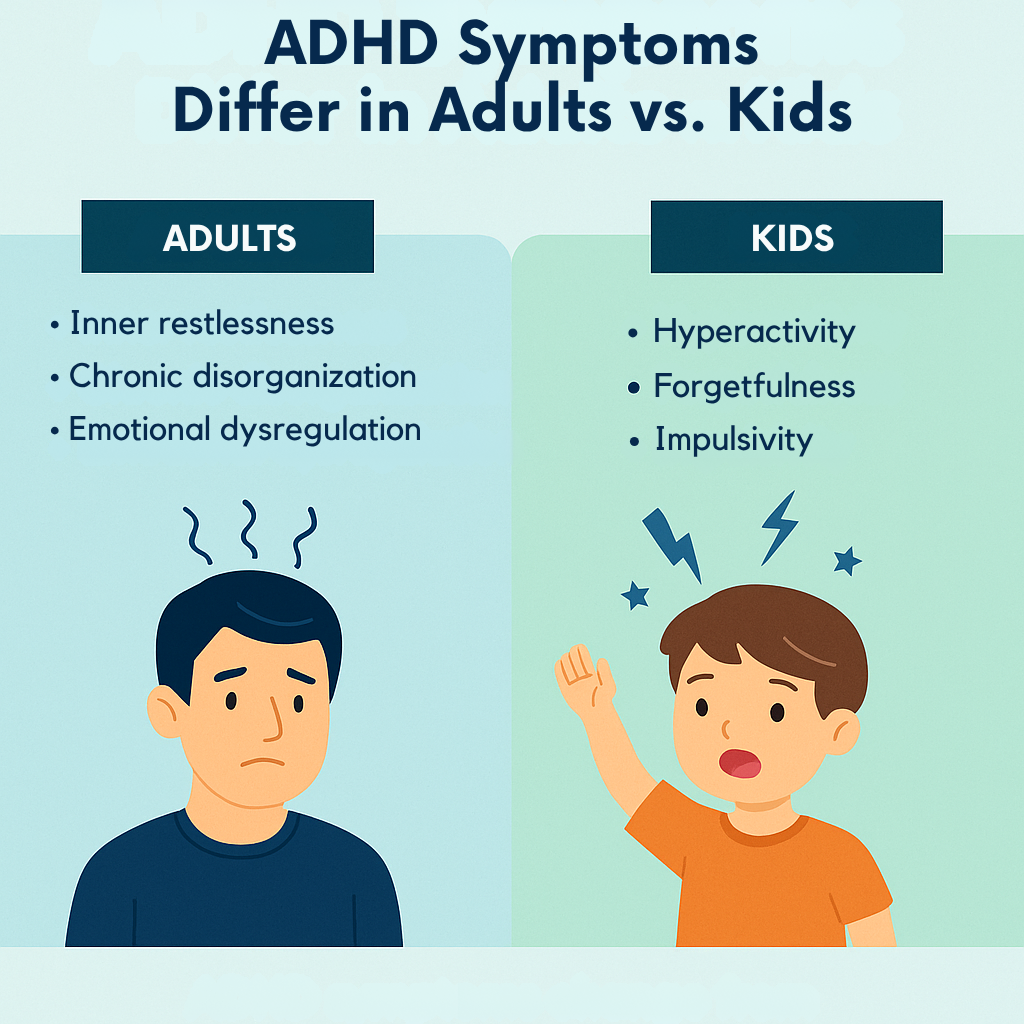When we think about ADHD, most of us imagine a hyperactive child bouncing off the walls or a student who can’t sit still in class. That image, though familiar, barely scratches the surface of what ADHD looks like across a lifetime.
The reality is that ADHD is not a condition people simply “grow out of.” Research suggests that more than half of children diagnosed with ADHD continue to show significant symptoms well into adulthood. How these symptoms show up and how they impact daily life can look entirely different between a child and an adult.
Children often get flagged for ADHD because they’re disruptive in class or struggle to finish assignments. Their symptoms are loud and visible: running around, climbing on things, blurting out answers, or constantly fidgeting. This hyperactivity can’t really hide, which is why teachers and parents often notice it early.
But as people age, outward hyperactivity tends to fade. Instead, what takes its place is often an inner restlessness or subtle difficulties that can quietly derail someone’s life.
From Playgrounds to Boardrooms: The Changing Face of ADHD
Consider a child who can’t stop squirming at school suddenly growing into an adult who struggles to sit through a meeting. Instead of climbing the furniture, an adult might feel a constant internal agitation, such as a buzzing energy that makes it hard to stay still or focused.
This restlessness is one of the many ways hyperactivity evolves over time. It becomes less obvious to those around them and sometimes even to the person experiencing it.
Inattention is another core symptom that doesn’t disappear. In kids, this might mean forgetting homework or losing toys. In adults, it can mean missing deadlines, overlooking important work tasks, or constantly misplacing keys and wallets.
What might have looked like simple forgetfulness in childhood transforms into chronic disorganization that interferes with careers and relationships. Adults with ADHD often describe their minds as constantly jumping from one thing to the next, making it hard to finish what they start.
The Hidden Struggles: Emotional Dysregulation and Executive Dysfunction
Perhaps the most misunderstood aspects of adult ADHD symptoms are emotional dysregulation and executive dysfunction. Emotional dysregulation refers to intense, quickly shifting emotions. An adult might go from calm to overwhelmed or frustrated in a matter of seconds.
These rapid mood swings are often misinterpreted as a personality flaw or even a separate mental health disorder like anxiety or bipolar disorder. In reality, they’re a core part of ADHD for many people.
Executive dysfunction, which refers to the struggle to plan, prioritize, and complete tasks, is another invisible barrier. Many adults with ADHD are labeled as “lazy” or accused of lacking willpower. They might leave projects unfinished, avoid tasks that seem overwhelming, or procrastinate endlessly.
But this isn’t about not caring. It’s about the brain’s wiring making these everyday tasks feel monumental. Chronic procrastination is a sign that the brain is having trouble organizing steps and pushing through discomfort.
The gap between external expectations and internal capacity can create intense feelings of shame. Adults may spend years believing they’re simply failing at life rather than recognizing they have a neurodevelopmental condition impacting their ability to function.
Why So Many Adults Go Undiagnosed
One reason many adults are left without a diagnosis is the longstanding misconception that ADHD is a childhood-only condition. For decades, diagnostic criteria were focused on children, and many mental health providers didn’t consider ADHD in adults at all. Additionally, many adults develop sophisticated coping mechanisms to manage their symptoms, which can make their struggles less obvious to others.
Gender and cultural expectations also play major roles. Girls, for example, are often taught to be quiet and polite. If a girl has inattentive ADHD that is marked more by daydreaming than hyperactivity, she might slip through the cracks.
As women grow up, they might be labeled as “spacey” or “anxious,” leading to misdiagnosis or no diagnosis at all. Similar challenges exist across cultural contexts, where behavioral expectations vary and certain symptoms are misinterpreted or dismissed.
Moreover, life transitions can unmask ADHD symptoms that were previously managed. Starting college, a demanding new job, or parenting can all reveal struggles that were hidden by structured environments. Suddenly, the coping strategies that kept someone afloat begin to fail, and symptoms become overwhelming.
Misdiagnoses and Missed Connections
Adults living with ADHD often find themselves labeled with depression, anxiety, or even personality disorders. Sure, these conditions can show up alongside ADHD, but they don’t explain the constant struggle to plan or the intense emotional waves that crash out of nowhere. When the true neurological roots go unrecognized, people are left feeling misunderstood and stuck.
Imagine being told for years to “just focus more” or “stop overreacting” when your brain simply isn’t wired that way. Over time, this kind of advice can wear someone down, leading to shame and even more self-doubt.
Recognizing adult ADHD symptoms as valid and not as moral failings can completely shift someone’s view of themselves. Instead of spiraling into self-blame, they might finally see, “Oh, this is why I operate the way I do. I’m not broken. I just process things differently.”
The Power of a Clear Assessment
Getting a proper ADHD evaluation as an adult can feel like taking a deep breath after years of holding it in. It isn’t just about ticking boxes on a checklist. A good assessment usually weaves together interviews, behavior surveys, and sometimes tech-based tools that track focus and movement in real time. It digs into how challenges pop up in work, relationships, and daily life.
Looking back at childhood behaviors is also part of it since ADHD begins early. This might mean gathering old school records or talking to family to paint a full picture. While it might feel intimidating, this process is what finally brings real answers and real relief.
Our Approach at Zeam
In some cases, ADHD symptoms overlap with or mask other psychiatric conditions like anxiety or depression. That’s why a comprehensive assessment may include not just behavioral screening, but also psychiatric evaluation and medication management if needed.
At Zeam Health & Wellness, our mental health team in Sacramento, Folsom, and Roseville knows how heavy this journey can feel. Our assessments combine clinical interviews and innovative tools like QB Check to give a full, personalized view. If you’re searching for ADHD testing near you, we’re here to guide you, help you understand your mind, and move you toward real progress.




